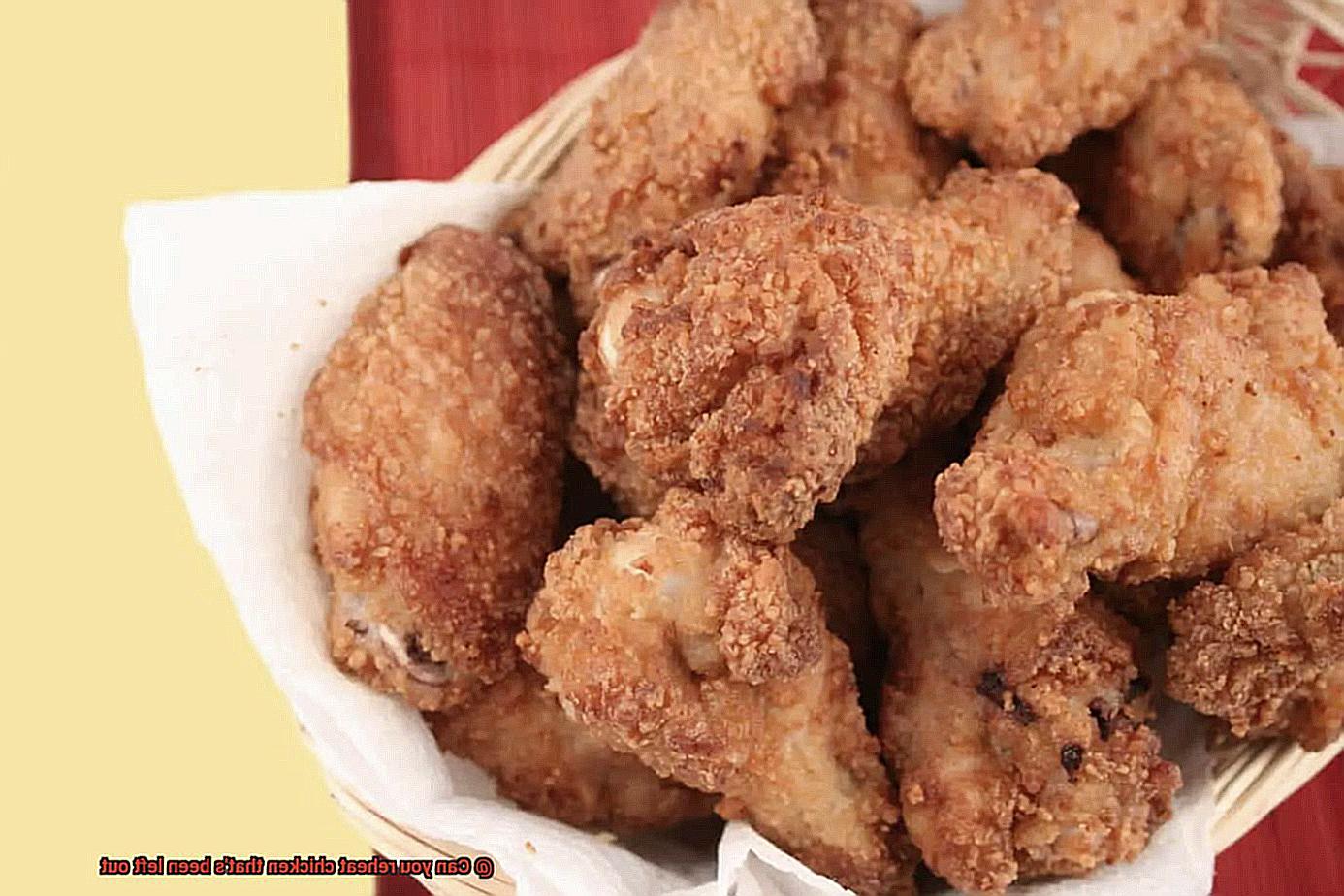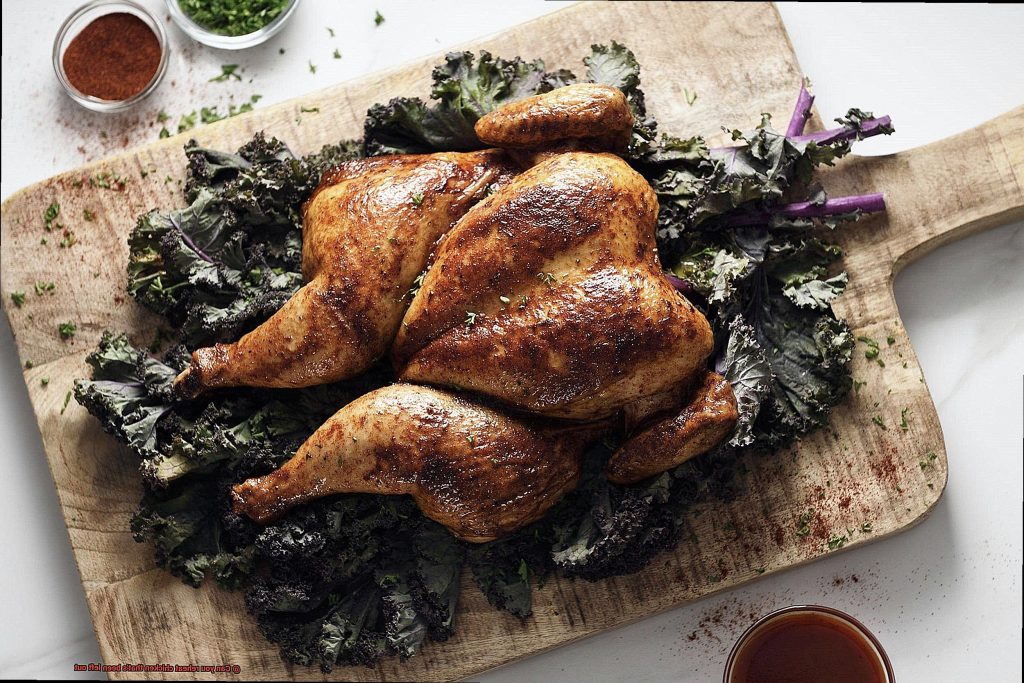Have you ever left your chicken leftovers out on the counter overnight? Or maybe you’ve been caught up in hosting duties and forgot about the chicken that’s been sitting out for a few hours during your party. We’ve all been there, but it’s crucial to know whether or not it’s safe to reheat chicken that’s been left out.
Chicken is a protein powerhouse and a staple in many of our diets. However, improper handling and storage can lead to harmful bacteria growth, resulting in foodborne illnesses.
In this blog post, we’ll explore the safety measures you should take when reheating chicken that’s been left out. We’ll also examine how long it takes for bacteria to grow on chicken and how to tell if your chicken is no longer safe to eat.
Whether you’re a busy parent or a party host extraordinaire, understanding the risks of eating leftover chicken that’s been left out too long is vital. So let’s dive into this topic together and learn the do’s and don’ts of reheating chicken that’s been left out.
Contents
What Happens When You Reheat Chicken That Has Been Left Out?
The answer to this question is not a straightforward one, as several critical factors come into play.
When chicken is left out at room temperature, bacteria can start to grow on it within two hours. These bacteria can produce toxins that can cause food poisoning, which can result in severe health risks. Therefore, if the chicken has been left out for more than two hours at room temperature, it is not safe to consume. This is because reheating chicken that has been left out does not kill all bacteria and toxins that may have grown on the chicken. In fact, reheating chicken improperly can worsen the situation by allowing the bacteria to grow even more, leading to serious health problems like salmonella, listeria, and E.coli.
It’s essential to store any leftover chicken in the refrigerator within two hours after cooking to ensure that it is safe to eat later. If you decide to reheat chicken that has been left out, make sure to heat it thoroughly to an internal temperature of 165°F (74°C). It’s also crucial to use a food thermometer to check the temperature of the thickest part of the chicken to ensure that it has been heated evenly.
If the chicken has a strange odor or appearance, it’s best to err on the side of caution and throw it away rather than risk getting sick. To ensure that chicken is safe to eat after being left out, it should be thrown away after two hours if the room temperature is above 90°F (32°C). If the temperature is below 90°F (32°C), then the chicken can be thrown away after four hours.
In conclusion, reheating chicken that has been left out can be risky. Still, proper storage and cooking techniques can help minimize foodborne illnesses. Remember, when in doubt, throw it out. Here’s a quick list of do’s and don’ts when it comes to reheating chicken that has been left out:

How Long Can Chicken Be Left Out Before It Is Unsafe to Reheat?
While it may be tempting to simply reheat last night’s dinner, it’s crucial to know how long chicken can be left out before it becomes unsafe to eat. According to the USDA, cooked chicken should not be left at room temperature for more than two hours. This is because bacteria thrive in temperatures between 40°F and 140°F, commonly referred to as the “danger zone.”
When chicken has been left out for more than two hours, it’s best to discard it rather than attempting to reheat it. The bacteria that may have grown on the chicken can produce toxins that cannot be destroyed by reheating. The same rule applies to any other cooked food that has been sitting at room temperature for too long.
It’s important to note that the two-hour rule is based on cooked chicken that has been left out in a room temperature environment. If the chicken was left out in a hotter environment, such as outside on a scorching day or near a heat source, it may become unsafe much quicker than two hours. In these cases, it’s best to trust your instincts and dispose of the chicken if you’re uncertain about its safety.
Now, what if you’re not sure how long your chicken has been sitting out? If the chicken feels warm or has been exposed to heat, it’s likely that it has become unsafe much quicker than two hours. However, if you’re lucky and your chicken has only been sitting out for an hour or so, you may still be able to reheat it. Keep in mind that this decision depends on various factors, such as how hot the chicken was when you initially took it out of the fridge.
What Temperature Should Chicken Be Stored At?
Let’s start with the “danger zone.” This temperature range between 40°F and 140°F is where bacteria thrive and multiply rapidly, making your chicken unsafe to eat. Therefore, it’s essential never to leave your chicken out at room temperature for more than two hours. If the temperature exceeds 90°F, reduce this time to one hour to avoid bacterial growth.
Now, let’s discuss the ideal storage temperature for chicken. To prevent bacterial growth, the magic number is 40°F or below. Always store your chicken in the refrigerator to maintain its freshness. If you don’t plan on using it within a few days, freeze it at 0°F or below. When thawing frozen chicken, never thaw it at room temperature as it can lead to bacterial growth. Instead, thaw it in the refrigerator or on the defrost setting of your microwave.
To sum up, always keep your chicken stored at or below 40°F to prevent bacteria growth and foodborne illness. Never leave your chicken unrefrigerated for more than two hours (or one hour if above 90°F). Always thaw frozen chicken in the refrigerator or on the defrost setting of your microwave.
Is it Safe to Reheat Undercooked Chicken?
Unfortunately, the answer is no. When chicken isn’t cooked to the correct temperature, bacteria like salmonella and campylobacter can thrive, leading to food poisoning.
To make matters worse, when chicken is left out at room temperature for too long, it becomes a breeding ground for bacteria. The USDA recommends not leaving chicken out for more than two hours. So, if you’ve got undercooked chicken that’s been sitting out for longer than that, you’re better off tossing it.
But what about reheating? Can’t we just pop it in the microwave and call it a day? Not so fast. Reheating undercooked chicken is just as risky as consuming it in its raw form. To make it safe to eat, you’ll need to cook it fully until it reaches an internal temperature of 165°F (74°C). And don’t rely on visual cues like color or texture – use a food thermometer to check the temperature.
And if you’ve got leftover cooked chicken that’s been sitting out at room temperature for more than two hours, don’t even think about reheating it. The risk of bacterial growth is simply too high. Instead, throw it out and start fresh.
How Do You Properly Store Cooked Chicken?
Firstly, it is essential to follow the guidelines for food safety to prevent harmful bacteria growth. Cooked chicken should be stored in an airtight container in the refrigerator within two hours of cooking it. And if you want to save it for later, cool it down to room temperature before placing it in the fridge. However, storing chicken at room temperature for too long can increase bacterial growth. It is not recommended to store cooked chicken at room temperature for more than two hours.
Moreover, avoid keeping your chicken in the refrigerator door as this area has fluctuating temperatures, leading to spoilage and bacterial growth. Instead, store it towards the back of the fridge where it’s consistently cold.
If you’re planning on freezing your cooked chicken, make sure to store it correctly in an airtight container or freezer bag. Frozen chicken can last up to six months if stored correctly. However, keep in mind that freezing can alter the texture and taste of the chicken. To reheat frozen chicken, let it thaw in the refrigerator overnight and then reheat it thoroughly before consuming.
It’s crucial to store your cooked chicken appropriately for maintaining its quality and preventing foodborne illnesses. By following these simple guidelines, you can ensure that your leftover chicken stays safe and delicious for future consumption.
What is the Best Way to Reheat Leftover Chicken?
If so, you know how important it is to reheat your leftover chicken safely without sacrificing its texture and taste. Fear not, as I’ve done the research for you and found the best ways to reheat your chicken to perfection.
Let’s start with the basics – proper storage. Always store your leftover chicken in an airtight container in the back of your fridge. Freezing is also an option, but ensure that it’s in a correctly sealed container and thaw it overnight in the fridge before reheating.
Now, onto the main event – reheating. The oven method is preferred as it heats up the chicken evenly, maintaining its juiciness while avoiding dryness or rubbery textures. Preheat your oven to 350°F, place the chicken in an oven-safe dish, cover it with foil, and bake for 20 minutes or until the internal temperature reaches 165°F. Remove the foil during the last 10 minutes of cooking if you want crispy skin.
If time is of the essence, microwaving is an alternative option. However, this method can dry out your chicken quickly if not done correctly. Place your chicken in a microwave-safe dish and cover it with a damp paper towel. Microwave on high for 2-3 minutes or until the internal temperature reaches 165°F. Let it rest for a minute before serving.
Remember – reheating chicken should only be done once to avoid potential food poisoning. Also, never leave cooked chicken out at room temperature for more than two hours as bacteria can grow rapidly at this temperature.
Are There Any Risks Associated With Reheating Leftover Chicken?
Delicious and convenient, reheating leftover chicken is a great way to enjoy a meal without the hassle of cooking from scratch. However, it’s important to be aware of the potential risks associated with this practice.
One of the most significant risks of reheating chicken is the growth of harmful bacteria like Salmonella and Campylobacter. These bacteria can cause food poisoning, which can lead to unpleasant symptoms like diarrhea, vomiting, fever, and abdominal cramps. To avoid this, it’s crucial to refrigerate or freeze leftover chicken as soon as possible after cooking it. If you do decide to reheat chicken that has been left out, make sure it’s heated to an internal temperature of at least 165°F (74°C) to kill any harmful bacteria.
Another risk of reheating leftover chicken is the formation of harmful chemicals called HCAs and PAHs. These chemicals can increase the risk of certain types of cancer and form when meat is cooked at high temperatures like grilling or frying. To minimize the risk of HCAs and PAHs forming when reheating leftover chicken, avoid overcooking or burning the meat. Consider using gentler cooking methods such as baking or boiling instead of grilling or frying.
To ensure safe and healthy consumption of leftover chicken, it’s essential to follow proper food safety guidelines. Here are some tips:
- Refrigerate or freeze leftover chicken as soon as possible after cooking.
- Reheat chicken to an internal temperature of at least 165°F (74°C).
- Avoid overcooking or burning the meat.
- Use gentler cooking methods such as baking or boiling.
- When in doubt, throw it out.
6NjWAt7PZQg” >
Conclusion
To sum up, reheating chicken that’s been left out is a risky move that can lead to harmful bacteria growth and foodborne illnesses. To avoid such unpleasant outcomes, it’s crucial to follow proper handling and storage techniques. Firstly, cooked chicken should be stored in an airtight container in the refrigerator within two hours of cooking it. If you’ve forgotten about your chicken and left it out for more than two hours at room temperature, unfortunately, it’s not safe to consume anymore due to the potential production of toxins by bacteria.
Reheating improperly handled chicken can worsen the situation by allowing bacteria to grow even more, leading to severe health problems like salmonella, listeria, and E.coli. Therefore, if you’re determined to reheat your leftover chicken that has been left out for some time, make sure to heat it thoroughly until its internal temperature reaches 165°F (74°C). To ensure even heating throughout the meat, use a food thermometer to check the temperature of the thickest part of the chicken. If you notice any strange odor or appearance in your chicken while reheating or before consuming it, don’t hesitate; throw it away immediately.
In conclusion, always store your cooked chicken appropriately for maintaining its quality and preventing foodborne illnesses. By following these simple guidelines, you can ensure that your leftover chicken stays safe and delicious for future consumption.






